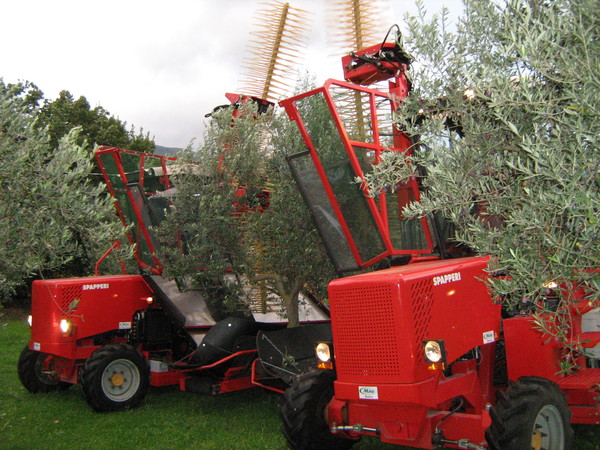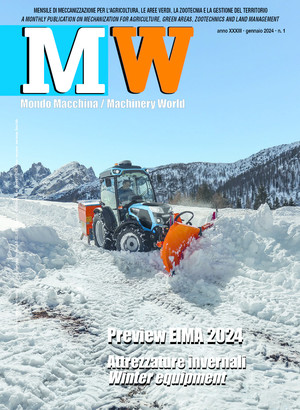
Miro Project, an innovative machine for olive cultivations
A project financed by the Rural Development Program for the Umbria Region has produced a prototype of a new concept machine which is especially efficient for harvesting and in other operations for olive cultivations. The new model will be manufactured on an industrial scale by the company Spapperi
Olive growers point to pruning and harvesting as the most expensive operations for the production of extra virgin olive oil, accounting for nearly two-thirds of their production costs.
Though these are the predominant operations, in addition there are those involving treatment of the foliage which helps to influence the overall economic factor. A recently completed project coordinated by the Umbrian Agro-Food Technological Park 3A-PTA in collaboration with the Spapperi S.r.l. metalworking industry and two Umbrian farming enterprises led to the production of a innovative multi-purpose prototype to meet the needs of lowering these leading production costs.
Utilizing financing provided by Rural Development Program (RDP) 2007-2013 – Measure 1.2.4, a Mirò Double System modular machine was built which enabled continuous olive harvesting either by beating the crowns of the trees or by vibrator shaking of the trunks or branches; secondly the machine can mechanize pruning; finally it can be used for pesticide treatments of the foliage.
The prototype is made up of two self-propelled machines capable of working together on both sides of the rows for mirror harvesting or on only one side. During the conference for the presentation of the results of the trials, held in Trevi dell’Umbria in April, demonstrations of mechanized continuous olive harvesting were staged on various layouts of groves, spacing and grove age: vase – 5x5 m in young and mature plants; single cone 6x3 m; the Frantoio, Leccino and Moraiolo cultivars.
It was found that the speed of work was slower than the speed generally reached by using trunk shakers but that the damage to the plants and the fruit was limited. The percentage of the fruit detached varied greatly, depending in part on the cultivar, but reached an acceptable level in the best of conditions.
The project based on two machines called for using the self-propelled units for all olive cultivation operations required, and for other crops, and various motorization couplings.
Examples are that the Miro Double System can be used for mechanical pruning thanks to an arrangement for mounting powered cutting discs in positions determined by the operator and a personnel basket can be mounted for an operator for pruning and trimming suckers to reach heights of 4/5 m.
The machine can also mount a mulcher for mulching pruning products and convey them to a dedicated hopper or a trailer towed by one self-propelled machine itself, be used for inter-row operations and perform plant treatment and foliage fertilization work thanks to the option of mounting tanks for sprayers.
The self-propelled multi-purpose machine is rated at medium power, runs on four wheels with two independent self-leveling rear wheels according to the morphology of the terrain and front 45° steering wheels mounted on an oscillating axle.
For harvesting green fruit with the two Mirò Double System machines facing each other three beater rakes are mounted on each for allowing the machines to work by duplicating their shape on each half of the tree.
For using the two self-propelled machines for harvesting with vibrating brushes, on the other hand, these are mounted on one unit and the other need only to be equipped with panels for intercepting the olives or other fruit harvested. If the self-propelled units are to be used for other hanging fruit products, such as apricots, almonds, walnuts, hazelnuts, pistachios, chestnuts, cherries and coffee beans, various accessories are mounted, each adapted to the type of fruit to be harvested.
The machines’ self-leveling works on inclines of up to 6%. Among the system’s noteworthy features are forward speed of 0.3 to 20 km/hr, air conditioned cabs housing the electronic controls, oscillating front axles, transport conveyor belts, weight at 2.5 tons, loading and unloading, a refrigerated hydraulic tank and 110 Hp.
Iveco engines. The farmers on hand for the trials showed interest in the machine for the opportunity the system can provide for lowering production costs with the positive fallout of financial sustainability for their cultivations and raising their competitiveness.
For the successive phase of industrial production of the machine, already on the Spapperi drawing boards, some components have to be perfected to adapt the system for work on various types of terrain and cultivation layouts.








